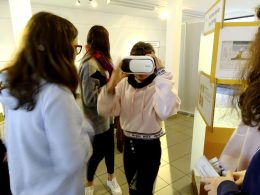A new exhibition at the National Museum is showing the history of video games over the last 50 years from 17 January to 13 April 2020. Visitors can play along and even try out VR.
Just a few decades ago, video games were considered a scientific gimmick. Today, gaming has become one of the most popular leisure activities. Between 2016 and 2019, the turnover of this still young industry rose by around 22 billion to almost 123 billion US dollars, making it more successful than the Hollywood film industry, for example. The National Museum Zurich is dedicating an exhibition to this extraordinary phenomenon.
From tennis for 2 to large arcades.
Today, around 2.5 billion people play games. That's a third of the world's population. The fascination with video games began in the 1950s in the USA. William Higinbotham made it possible for all sports enthusiasts to play tennis from the comfort of their sofa. The physicist's "Tennis for Two" was the second video game in the world and the real start of development. From the 1970s at the latest, games became an economic factor to be taken seriously.
Electronic games found their way into the living room and were marketed as a family activity. At the same time, video games also made their way into public spaces. In amusement arcades, they became serious competition for the previously popular pinball machines. A golden era was dawning: The era of arcade games. In restaurants, shopping centres or at airports, you could play games such as "Pac-Man" or "Space Invaders" and many a contemporary gambled away all their pocket money on the popular boxes.
... to parties and finally VR
A decade later, the first LAN parties took place. Gamers got together and connected their computers via a local network to play games together. In some cases, these groups filled entire halls. At the same time, the computer industry developed mobile devices, making it possible to play games on the move and online. In the new millennium, video games were finally combined with virtual reality. Complete immersion in the game worlds was a completely new experience.
"The selection of exhibits for the 2010s was more difficult," says co-curator Michael Kempf. "In the end, we decided in favour of a purely virtual reality room, as many of our visitors probably don't have VR headsets at home and can try them out here."

Ruppert has developed a video game especially for the exhibition, which is based on the Website of the State Museum can be played. "We wanted to test how people react to advertising through a game," says Swiss game designer Alice Ruppert.
Critical view
"When designing the exhibition, we had a young audience in mind, such as school classes, for whom it is very interesting due to its interactivity," says Stuber. But it is also attractive to an older audience, and not just because of the nostalgia factor. "Grandparents can easily visit the exhibition with their grandchildren and have the children explain things to them for once," says Michael Kempf.
However, the exhibition also casts a critical eye on the development of games over the years. On the many screens spread across the rooms, the "toxic" category deals with topics such as gaming addiction and violence in video games.
Game stations invite visitors to immerse themselves in virtual worlds and try out the games for themselves. Admission is free for young people up to the age of 16 and costs 10 francs for adults. With this in mind, let's play!
Source: National Museum, 20 Minuten









